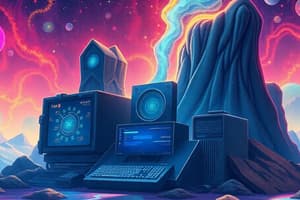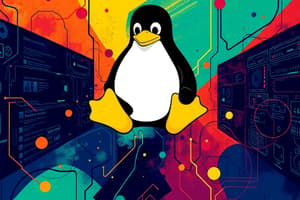Podcast
Questions and Answers
What is one of the key features of Linux that distinguishes it from many other operating systems?
What is one of the key features of Linux that distinguishes it from many other operating systems?
- It is owned by a single corporation.
- It has a proprietary source code.
- It requires paid licenses for distribution.
- It is open-source and modifiable. (correct)
Who initiated the development of Linux and in what year was the first version released?
Who initiated the development of Linux and in what year was the first version released?
- Richard Stallman in 1993
- Steve Jobs in 1989
- Bill Gates in 1990
- Linus Torvalds in 1991 (correct)
Why is Linux considered a stable operating system?
Why is Linux considered a stable operating system?
- It is less susceptible to viruses than other systems.
- It can operate without requiring frequent reboots. (correct)
- It runs many applications simultaneously without issues.
- It offers unlimited customization options.
In which applications has Linux gained popularity since the early 2000s?
In which applications has Linux gained popularity since the early 2000s?
What is a significant characteristic of Linux's development model?
What is a significant characteristic of Linux's development model?
What is the primary function of the kernel in the Linux operating system?
What is the primary function of the kernel in the Linux operating system?
Which component is responsible for user interaction through command entry in Linux?
Which component is responsible for user interaction through command entry in Linux?
Which of the following statements about system calls is accurate?
Which of the following statements about system calls is accurate?
What does the init system do during the Linux boot process?
What does the init system do during the Linux boot process?
How does Linux manage memory efficiently?
How does Linux manage memory efficiently?
Flashcards are hidden until you start studying
Study Notes
Overview of Linux
- Free and open-source operating system, initially introduced by Linus Torvalds in 1991.
- Evolved into a widely used OS for desktop systems, servers, and mobile devices.
- Open-source nature allows access, modification, and distribution of source code without licensing restrictions.
- Highly modular, enabling users to choose and configure components according to their needs.
- Renowned for stability and reliability, capable of prolonged operation without reboots.
Historical Context
- Development began in the early 1990s as a personal project for Linus Torvalds.
- First version, Linux 0.01, released in September 1991, intended for free public access.
- Gained popularity in enterprise applications by the early 2000s, becoming an alternative to proprietary operating systems.
Community and Licensing
- Not owned by any individual or corporation; developed collaboratively by a global community of contributors.
- Released under the GNU General Public License (GPL), promoting free software principles.
System Architecture
- Hardware Layer: Consists of physical components, including CPU, RAM, storage devices, and peripherals.
- Kernel: Core of the OS responsible for direct hardware interaction, resource management, and system calls.
- Shell and CLI: Command-line interface for user interaction with the kernel, enabling command input.
- System Libraries: Essential collections of functions that support applications and kernel operations.
- System Calls: Interfaces for user-level applications to interact with the kernel, including common operations like open() and read().
Boot Process
- Step 1: BIOS/UEFI: Initiate the boot process when the computer is powered on.
- Step 2: Kernel Initialization: Kernel detects hardware, sets up memory, and initializes essential subsystems.
- Step 3: Init System: Manages system services and initializes user space (e.g., systemd).
- Step 4: User Space Initialization: User space processes, including the shell, are spawned by the init process.
- Step 5: User Login: Graphical displays prompt for login credentials.
User Interaction and System Management
- Step 6: Shell and CLI: Presents user with a shell prompt post-login for command input.
- Step 7: File System Management: Hierarchical file system navigated with commands like ls, cd, cp, and mv.
- Step 8: Process Management: Kernel manages processes, with commands such as ps and kill for process control.
- Step 9: Memory Management: Employs virtual memory for efficient management of RAM and disk space.
- Step 10: Networking: Robust networking stack supports multiple protocols for connectivity.
- Step 11: Package Management: Package managers (e.g., APT, YUM) facilitate software installation, updates, and removal.
- Step 12: Security: Security model based on user permissions and ownership paradigms.
Conclusion of User Session
- Step 13: User Logout and Shutdown: Procedures followed when a user logs out or when the system is powered down.
Studying That Suits You
Use AI to generate personalized quizzes and flashcards to suit your learning preferences.




